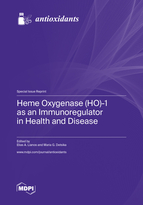Heme Oxygenase (HO)-1 as an Immunoregulator in Health and Disease
A special issue of Antioxidants (ISSN 2076-3921). This special issue belongs to the section "Antioxidant Enzyme Systems".
Deadline for manuscript submissions: closed (15 September 2022) | Viewed by 30757
Special Issue Editors
Interests: complement cascade; kidney injury; glomerulus; heme-oxygenase (HO)-1; decay accelerating factor (DAF); complement regulatory proteins
Interests: complement cascade; kidney injury; glomerulus; heme-oxygenase (HO)-1; decay accelerating factor (DAF); complement regulatory proteins; sepsis; COVID-19; heme; metalloporphyrins
Special Issue Information
Dear Colleagues,
The current issue focuses on the role of heme oxygenase (HO)-1 as an immunoregulatory molecule. HO-1 is a well-established cytoprotective enzyme mainly through the enzymatic conversion of heme into by-products, biliverdin, bilirubin and carbon monoxide (CO), which have been shown to have strong anti-apoptotic and antioxidant properties. However, HO-1 also regulates responses to injury via mechanisms that are independent of production of heme degradation products. Key among these responses is immune regulation including effects on innate immunity, adaptive immunity and complement activation.
Understanding mechanisms of immune regulation by HO-1 could lead to novel therapeutic strategies in various forms of immune-mediated injury and autoimmune diseases, cancer and transplantation. This Special Issue aims to provide an update of current knowledge on HO-1 as an immunomodulatory molecule and to serve as a detailed, analytical and up-to-date guide on this specific subject.
Prof. Dr. Elias A. Lianos
Guest Editor
Dr. Maria G. Detsika
Co-Guest Editor
Manuscript Submission Information
Manuscripts should be submitted online at www.mdpi.com by registering and logging in to this website. Once you are registered, click here to go to the submission form. Manuscripts can be submitted until the deadline. All submissions that pass pre-check are peer-reviewed. Accepted papers will be published continuously in the journal (as soon as accepted) and will be listed together on the special issue website. Research articles, review articles as well as short communications are invited. For planned papers, a title and short abstract (about 100 words) can be sent to the Editorial Office for announcement on this website.
Submitted manuscripts should not have been published previously, nor be under consideration for publication elsewhere (except conference proceedings papers). All manuscripts are thoroughly refereed through a single-blind peer-review process. A guide for authors and other relevant information for submission of manuscripts is available on the Instructions for Authors page. Antioxidants is an international peer-reviewed open access monthly journal published by MDPI.
Please visit the Instructions for Authors page before submitting a manuscript. The Article Processing Charge (APC) for publication in this open access journal is 2900 CHF (Swiss Francs). Submitted papers should be well formatted and use good English. Authors may use MDPI's English editing service prior to publication or during author revisions.
Keywords
- heme oxygenase (HO)-1
- immune system
- immune response
- inflammation
- complement
- autoimmunity
- immune-mediated injury







